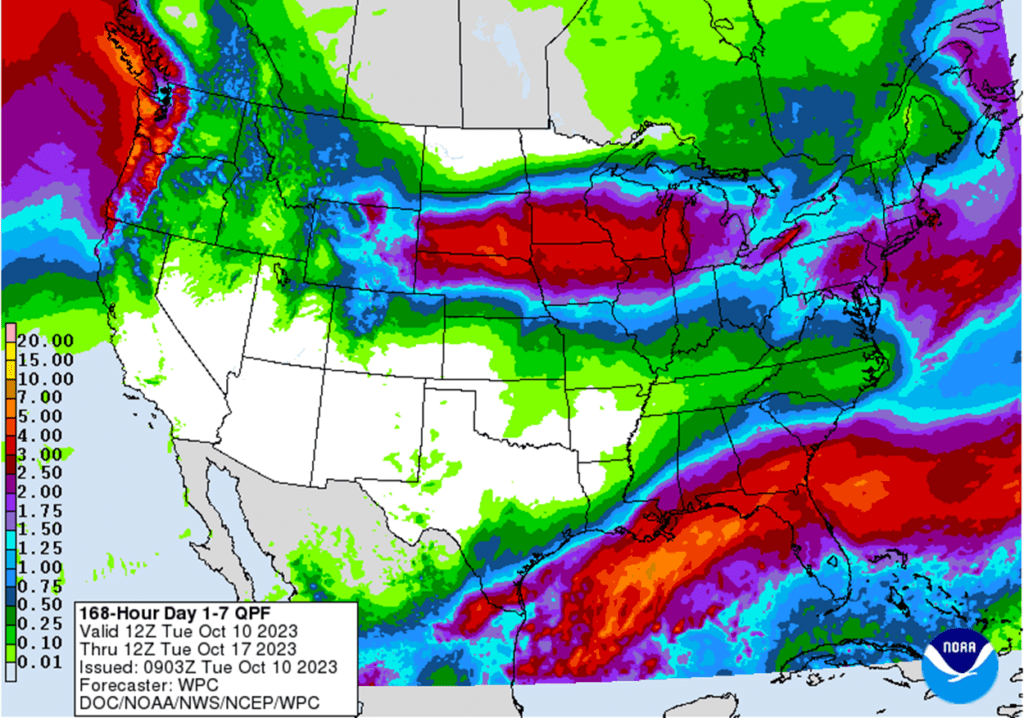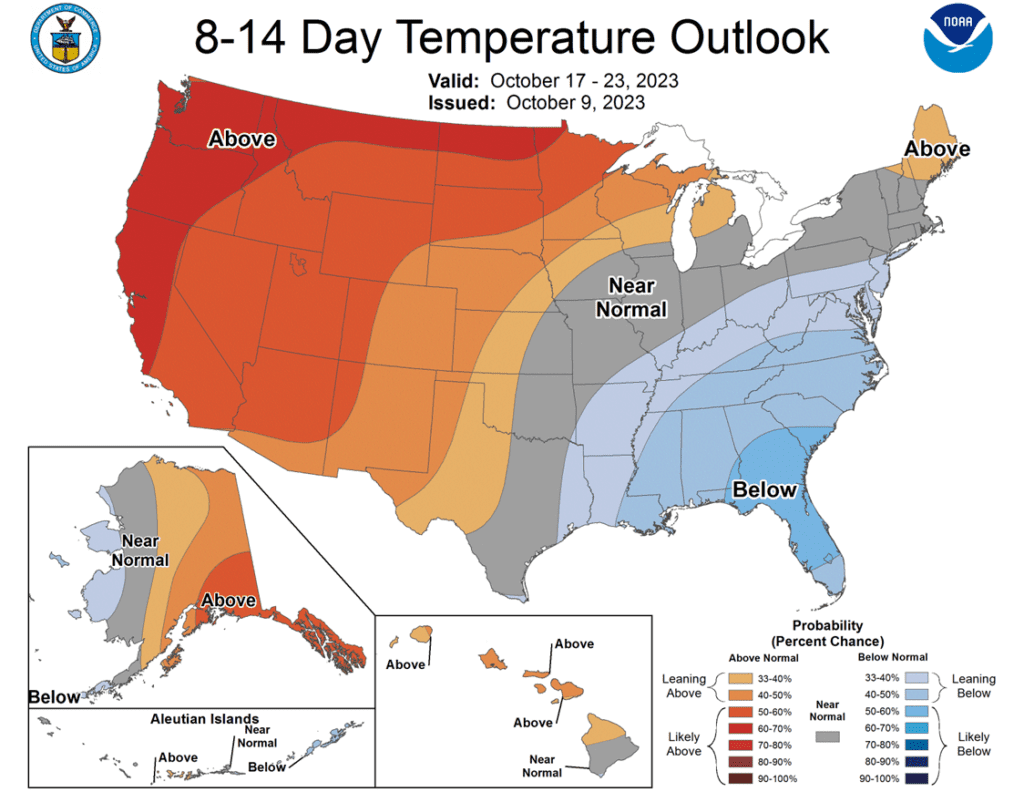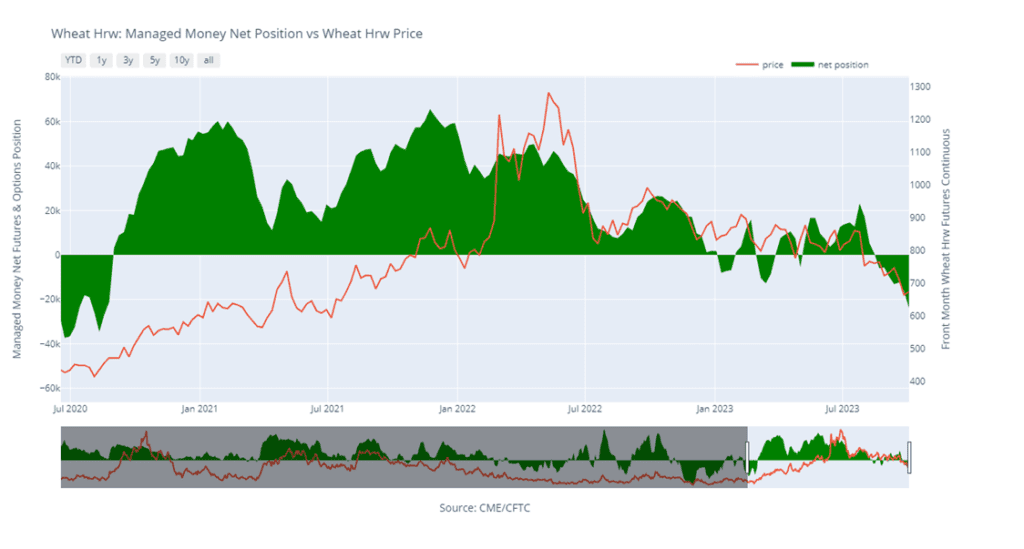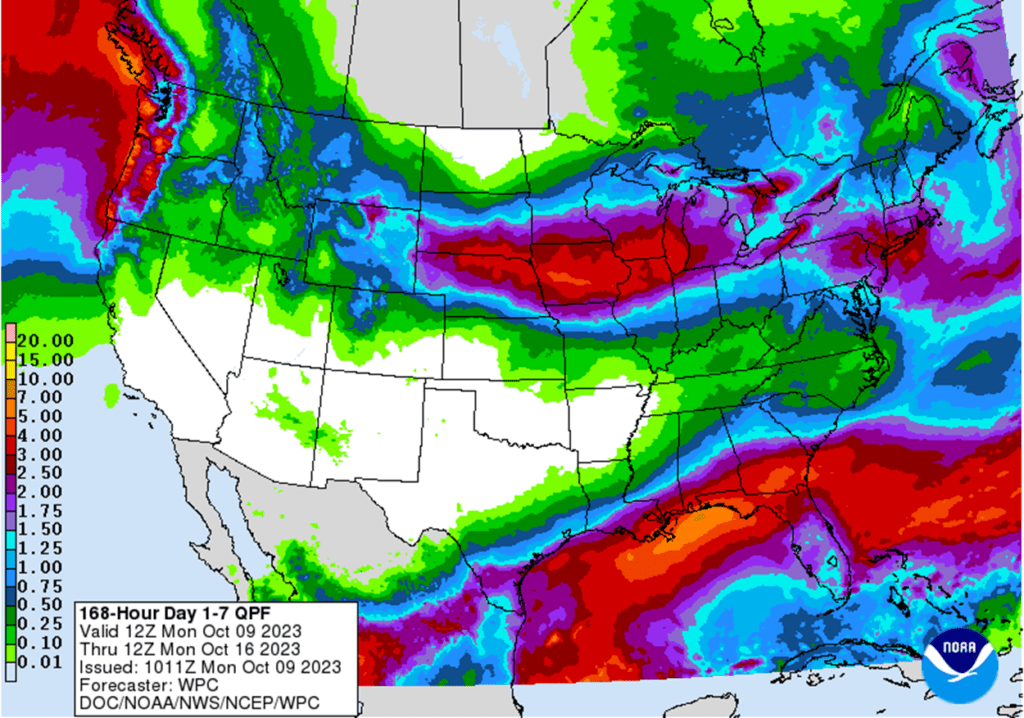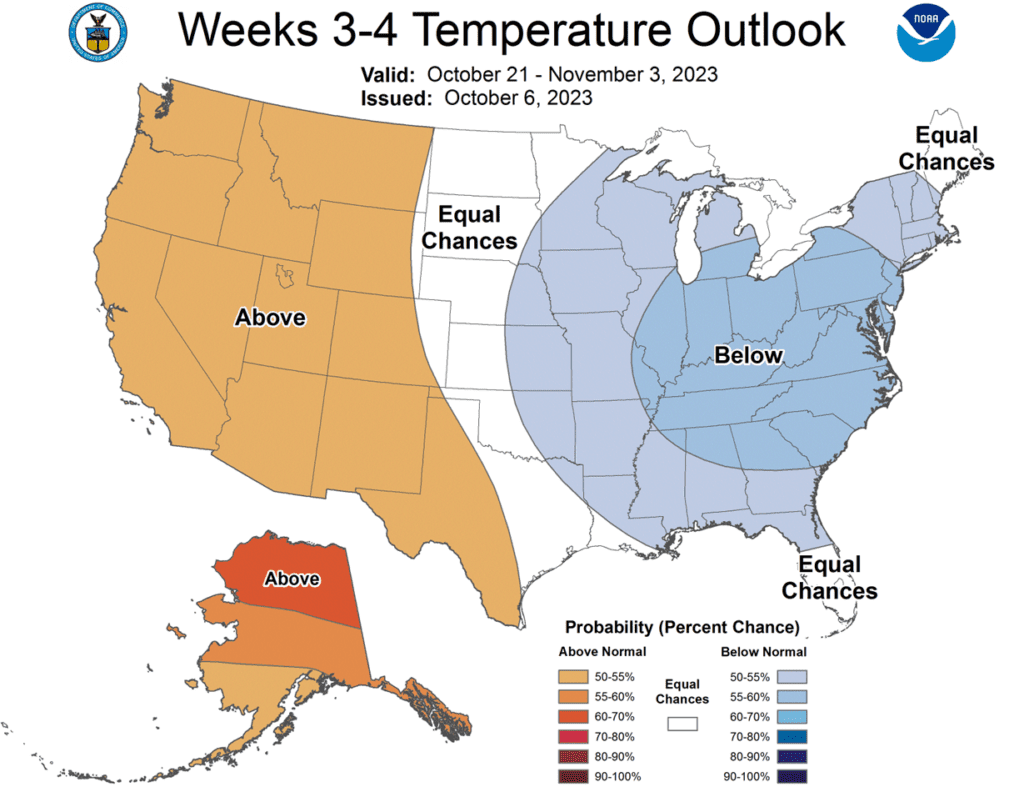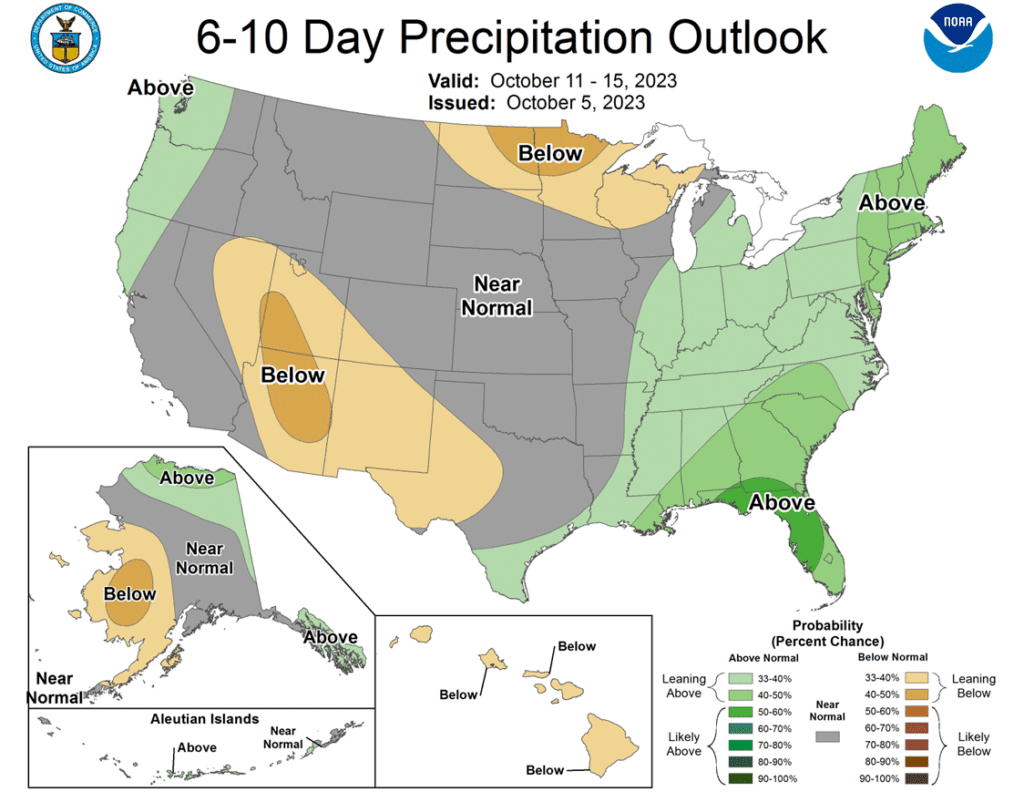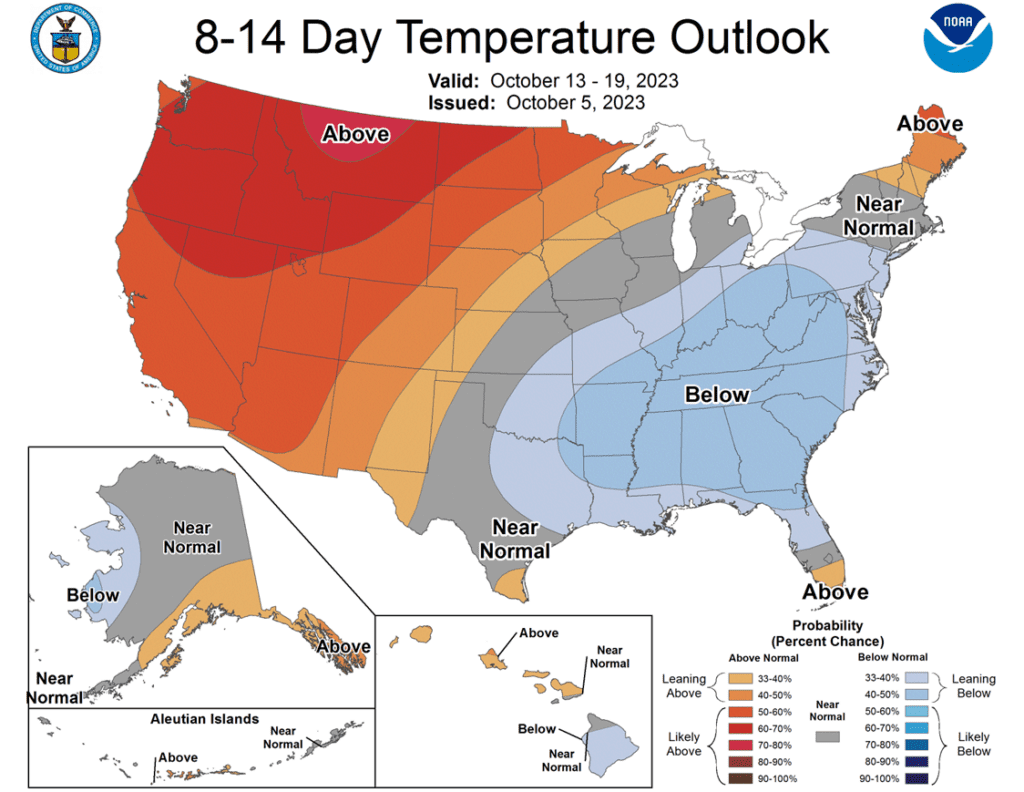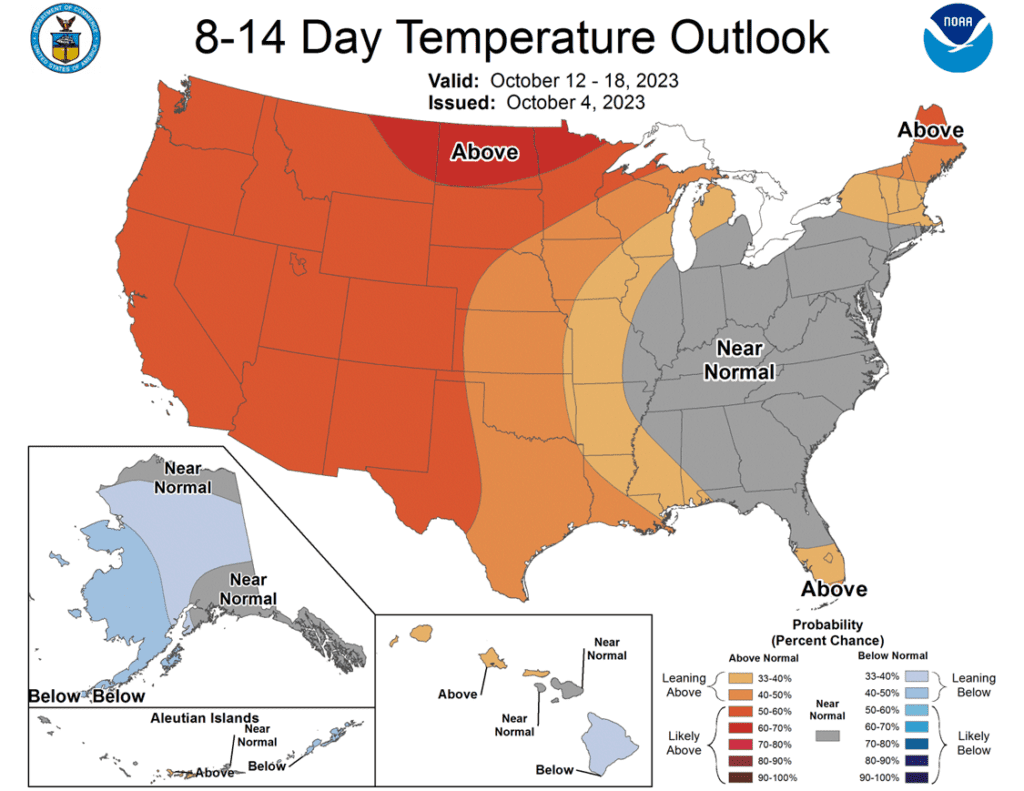Grain Market Insider: October 10, 2023
All prices as of 2:00 pm Central Time
Grain Market Highlights
- Harvest pressure and carryover weakness from the wheat market conspired to pressure the corn market to a lower finish following choppy trade in today’s session.
- Strong export inspections that were well above expectations supported the front end of the soybean market, that rallied from its lows to finish within 2 cents of the day’s high.
- Soybean meal also rallied along with the bean market while soybean oil found pressure from the weak biofuel RIN values and lower world veg oil prices.
- While the wheat complex continues to consolidate, all three classes traded lower on the day, in classic turnaround Tuesday fashion, as the market refocused on lackluster demand, with weak weekly export inspections and year-to-date totals that fall behind last year by 29%.
- The U.S. Dollar traded lower today as hawkish comments from Federal Reserve officials stated that the recent increase in bond yields may reduce the need for additional rate hikes. Additionally, at the dollar’s peak on October 3, the Bank of Japan sold U.S. Dollars to support the yen. Any further weakness in the dollar will likely help U.S. exports be more competitive in the world market.
- To see the current U.S. 7-day precipitation forecast, the 8 – 14 day Temperature and Precipitation Outlooks, and South American 1 week precipitation forecasts from the NWS and NOAA, scroll down to other Charts/Weather Section.
Note – For the best viewing experience, some Grain Market Insider content is best viewed with your phone held horizontally.
Corn
Corn Action Plan Summary
- No new action is recommended for 2023 corn. The last couple weeks Dec ’23 corn has seen a bump from a low of 467.75 to a high last week of 499.00. Since mid-August, the psychological 500.00 level has served as market resistance on the front month. Without any bullish catalyst from the coming USDA Supply and Demand report this Thursday, the market remains at risk of sideways to lower price action. In years without bullish fundamental tailwinds at this time of year, the worst case scenarios have seen prices trend slowly lower into anywhere from late November to early January. If you’re new to Insider and were not a subscriber during this summer’s rally, Insider did recommend making sales into that summer rally when Dec ’23 was around 624.00, so for now the thought process is to hold tight on any further sales recommendations until later this fall or early winter, with the objective of seeking out better pricing opportunities. If the market has not turned around by early winter, then Insider may sit tight on the next sales recommendations until next spring. If you end up harvesting more bushels than you can store this fall and must move them, consider re-owning those bushels with either July or September ’24 call options.
- No new action is recommended for 2024 corn. The Dec ’24 contract has held up better than Dec ’23 as bear spreading over the last several months has brought increased buying interest into Dec ’24 and other further out contract months. Back in late July, the Dec ’23 contract traded up to a 25-cent premium over Dec ’24. Now Dec ’24 holds a 28-cent premium over Dec ’23. This bear spreading has the Dec ’24 price up about 28 cents from its year-to-date low. The risk for 2024 prices is the same as 2023 prices, which is a continuation of a lower trend without a bullish catalyst on this Thursday’s Supply and Demand report. Insider is watching for signs of a change in the current trend to look at recommending buying Dec ’24 call options. This past spring, Insider recommended buying 560 and 610 Dec ’23 call options ahead of the summer rally, and having those in place helped provide confidence to pull the trigger on recommending 2023 sales into that sharp rally, knowing that if corn kept rallying and went to 700.00 or 800.00 that the call options would protect those sold bushels.
- No Action is currently recommended for 2025 corn. Insider isn’t considering any recommendations at this time for the 2025 crop that will be planted two springs from now. It will probably be late winter or early spring of 2024 before Insider starts considering the first sales targets.

Grain Market Insider has issued the following number of corn recommendations:
• 2023: 1 Cash/2 Call/2 Put
• 2024: 2 Cash/0 Call/0 Put
• 2025: 0 Cash/0 Call/0 Put
- Corn futures finished lower on the day as harvest pressure and selling in the wheat market weighed on the corn futures. December corn finished 2 ¾ cents lower but held above the $4.85 initial support level.
- The USDA will release the next round of crop progress numbers on Tuesday afternoon. Corn harvest is expected to be near 35% complete.
- Weekly export inspections for last week were released today after the Columbus Day holiday yesterday. Last week, USDA shipped 551,000 MT (21.7 mb) of corn. Total inspections for the 23/24 marketing year are at 128 mb, up 14% from last year. The USDA is forecasting corn exports to be 2.050 bb, a 23% increase over the last marketing year.
- The weather forecast for the first half of the week looks overall friendly to keep harvest pace moving along. Projected moisture in the 2nd half of the week going into the weekend may slow harvest progress going into next week for north and central areas of the Corn Belt.
- The market will likely stay choppy this week as the market prepares for the USDA’s WASDE report on Thursday, October 12. Expectations are for corn yield and production to be reduced slightly. Any possible demand adjustments will be the key to determining the carryout projections.

Above: The corn market has largely been rangebound since the beginning of August, with some minor short covering lifting prices in recent days. Resistance remains above the market between 490 – 516, and support below the market may be found near 460 and again near 415.
Soybeans
Soybeans Action Plan Summary
- No new action is recommended for 2023 soybeans. The Nov ’23 contract has been finding buying interest around the June 2023 low of 1256.75 on the front month. Over the last seven trading days, Nov ’23 has traded largely between 1260.00 and 1280.00. If there were to be a bullish catalyst from this Thursday’s USDA Supply and Demand report and Nov ’23 subsequently closed over 1287.25, that could signal the possibility that a harvest/fall low is in. Bigger picture, since May 2023, the front month contract has traded in a range from 1256.75 on the downside to 1435.00 on the topside. If you are a newer subscriber to Insider and were not with us back in the summer, Insider did make two sales recommendations in the 1310-1360 price window versus Nov ’23. Given those sales recommendations were already made and given that now is not the time of year to be making many if any sales, Insider is content to hold tight on next sales recommendations until later this fall or early winter. The focus for strategy right now is to be on the lookout for any call option buying opportunities. If you end up harvesting more bushels than you can store this fall, consider buying those sold bushels back with July or August ’24 call options.
- No action is recommended for the 2024 crop. Nov ’24 continues to trade at a discount to Nov ’23. That discount was over 90 cents in late summer yet has stabilized lately around the 10-20 cent range. Since July, the Nov ’24 contract has largely traded between 1250 and 1320, so this contract is currently testing the bottom end of that range. To date, Insider has not recommended any sales for next year’s soybean crop. First sales targets will probably be early winter at the soonest. Currently, Insider’s focus is also on watching for any opportunities to recommend buying call options.
- No Action is currently recommended for 2025 Soybeans. 2025 markets are very illiquid right now, and it may be some time before conditions are conducive to consider making any recommendations. Be patient as we monitor the markets for signs of improvement.
Grain Market Insider has issued the following number of soybean recommendations:
• 2023: 2 Cash/0 Call/0 Put
• 2024: 0 Cash/0 Call/0 Put
• 2025: 0 Cash/0 Call/0 Put
- Soybeans ended the day higher in the front months after a lower open, while November ‘24 beans closed slightly lower. Soybean meal also ended higher, while soybean oil was lower amid a down day in world veg oils. Solid export inspections were supportive for the soy complex today.
- Export inspections were the best that have been seen in months. The USDA initially released the inspections number at 1.643 mmt, but that turned out to be a slight error with the real number coming in at 1.036 mmt, still very impressive.
- Supplies of soybeans in Brazil appear to be tightening, giving the U.S. a good opportunity to export beans. China has been an active buyer out of the PNW for October through December, and barge rates have been coming down, so that may provide more opportunity, though soybeans will need a continued bump in demand to justify a rally.
- Estimates for Thursday’s WASDE report call for soybean yields to fall slightly to 49.9 bpa from 50.1 bpa in last month’s estimate. Production is expected to be lowered slightly to 4.134 bb. It is unknown if the USDA will make adjustments to demand in this report.

Above: Since the end of August, the soybean market has been in a downtrend, and though it has been consolidating, it remains oversold, which can be supportive if prices turn higher. Initial support to the downside lies near the recent low of 1254, with further support between 1238 – 1214, while resistance above the market lies between 1285 – 1323.
Wheat
Market Notes: Wheat
- Wheat reversed yesterday’s trend, finishing today’s session with double-digit losses in Chicago and K.C., despite rising tensions in the Middle East and the Black Sea. Paris milling wheat futures also lost about 2.75 to 3.25 Euros today, suggesting that today’s negativity might not be fundamental in nature. Rather, the funds may have added to short positions, and begun positioning ahead of Thursday’s WASDE report.
- Fundamentally, global wheat production is setting a bullish backdrop for the marketplace. Growing regions in Australia and Argentina are very dry, and southern Brazil has seen enough rain to cause flooding. Which is also causing concern about their wheat production and quality. With that said, western and central Brazil, along with Argentina, have better chances for good rain in some of the longer range forecasts.
- Today’s wheat export inspections data initially showed inspections of about 395,000 mt, which was incorrect. A correction was later issued that totaled 265,242 mt, or 9.75 mb.
- Ag Resource is projecting an Argentine wheat crop of 15.2 mmt, compared to the USDA estimate of 16.5 mmt. And because of the El Nino weather pattern, some analysts are estimating that Australia’s crop could be down by as much as 50%.
- Although they raised their corn harvest estimate to 12.1 mmt from 11.5 mmt, France kept their soft wheat production estimate unchanged at 35.1 mmt, which compares to last year’s 33.7 mmt.
Chicago Wheat Action Plan Summary
- No new action is currently recommended for 2023 Chicago wheat. The wheat market in recent weeks has been sensitive to slow export demand, weather, and headlines regarding the Black Sea region.Now with harvest behind us, and new crop planting upon us, markets can still change suddenly due to El Nino and unforeseen geopolitical events, even though export demand remains weak. Following the recent recommendation to make an additional sale for the 2023 crop, Insider will continue to watch for any violations of support while also looking for prices to reach 600 – 650 before suggesting any further sales.
- No new action is recommended for 2024 Chicago wheat. Considering slow export demand and cheap Russian prices continue to be major headwinds for U.S. prices, Insider recommended buying July ’24 puts to protect unsold grain if prices continue to retreat further. There is plenty of time to market the 2024 crop and with the world stocks to use ratio at an 8-year low, many uncertainties remain that could shock prices higher, like geopolitical instability and dryness in the southern hemisphere. If prices turn around and rally higher, Insider will be looking for opportunities to consider recommending additional sales north of 750, if not, and prices make new lows, unsold bushels will be protected by the recommended July ’24 590 puts.
- No action is currently recommended for 2025 Chicago Wheat. 2025 markets are very illiquid right now, and it may be some time before conditions are conducive to consider making any recommendations. Be patient as we monitor the markets for signs of improvement.

Grain Market Insider has issued the following number of Chicago wheat recommendations:
• 2023: 1 Cash/0 Call/0 Put
• 2024: 2 Cash/0 Call/1 Put
• 2025: 0 Cash/0 Call/0 Put

Above: December wheat has been consolidating since the break on September 29. The market’s previous range of 570 – 618 is an area of resistance which will need more bullish input to rally through. If the market breaks further, support below the market resides between 533 – 524.
KC Wheat Action Plan Summary
- No new action is recommended for 2023 K.C wheat crop. Since the end of May the wheat market has been influenced by weak demand, changing headlines from the Black Sea region, and the corn market with its own demand and weather concerns. With harvest in the bin, U.S. production has been better than expected and demand remains weak. Still, many supply questions remain unanswered from the Black Sea region and the southern hemisphere, which could push prices in either direction. While Insider will continue to monitor the downside for any breach of major support, we would need to see prices pushed toward 700 – 750 before considering any additional sales.
- No new action is recommended for 2024 K.C. wheat. This year has been dominated by production concerns regarding the 2023 crop, and considering slow export demand and cheap Russian exports continue to be major headwinds for U.S. prices, Insider recommended buying July ’24 puts to protect unsold grain if prices continue to retreat further, while war persists in the Black Sea region, and production concerns continue in the southern hemisphere due to El Nino. With the world stocks to use ratio at an 8-year low, there are still many uncertainties that could shock prices higher, and plenty of time remains to market the 2024 crop. After recommending buying July ’24 660 puts, unsold bushels will be protected if prices make new lows, and Insider will also be looking for opportunities to consider recommending additional sales if prices turn around and rally north of 775.
- No action is currently recommended for 2025 KC Wheat. 2025 markets are very illiquid right now, and it may be some time before conditions are conducive to consider making any recommendations. Be patient as we monitor the markets for signs of improvement.

Grain Market Insider has issued the following number of K.C. wheat recommendations:
• 2023: 0 Cash/0 Call/0 Put
• 2024: 1 Cash/0 Call/1 Put
• 2025: 0 Cash/0 Call/0 Put

Above: Since the end of September, K.C. wheat has been consolidating after finding initial support just below the market near 660. If the market resumes its downtrend, the next levels of support below 660 come in around 630 and then 575, while resistance to the upside may be found between 710 – 722.
Mpls Wheat Action Plan Summary
- No new action is currently recommended for the 2023 New Crop. Weather has been a dominant feature this season with production concerns not only in the U.S., but also Canada, and Australia. While prices have been weak due to low export demand, weather and geopolitical events can change suddenly to move prices higher. If prices move towards 750 – 800, Insider will consider making sales suggestions, while also continuing to watch the downside for any further violations of support.
- No new action is currently recommended for 2024 Minneapolis wheat. This year has been dominated by production concerns regarding the 2023 crop, and considering slow export demand and cheap Russian prices continue to be major headwinds for prices, Insider recently recommended buying July ’24 K.C. wheat puts to protect unsold grain if prices continue to retreat further, while war persists in the Black Sea region, and production concerns continue in the southern hemisphere due to El Nino. With the world stocks to use ratio at an 8-year low, there are still many uncertainties that could shock prices higher, and plenty of time remains to market the 2024 crop. After recommending buying July ’24 K.C. wheat 660 puts for the liquidity and high correlation to Minneapolis wheat’s price movements, unsold bushels will be protected if prices make new lows, and if prices turn around and rally towards 800, Insider will be looking for opportunities to consider recommending additional sales.
- No action is currently recommended for the 2025 Minneapolis wheat crop. 2025 markets are very illiquid right now, and it may be some time before conditions are conducive to consider making any recommendations. Be patient as we monitor the markets for signs of improvement.

Grain Market Insider has issued the following number of Minneapolis wheat recommendations:
• 2023: 1 Cash/0 Call/0 Put
• 2024: 1 Cash/0 Call/1 Put
• 2025: 0 Cash/0 Call/0 Put

Above: Since early September, Dec Minneapolis wheat has been largely rangebound, and the recent breakout to the downside on September 29 has the market poised to test support near the May ’21 low of 665. If prices turn higher, initial resistance may be found between 745 – 760.
Other Charts / Weather
